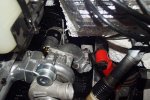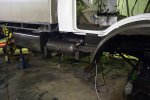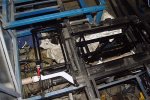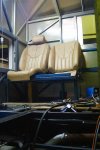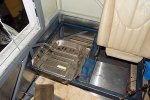Time for an update on the Mog progress. I have borrowed a cab tilter from a a forum member - I have it until early in January, so I need to get everything done that needs the cab tilted. I will also take a few measurements on the lifting cylinder at various extensions to see how long to make a single ram cylinder.
There is plenty of clearance for the turbo - I'll tilt the cab again and fit the heat shields and a bit more sound insulation. I will also fit up the accelerator pedal and the hand throttle linkages.
I also re-fitted the inner fenders - both refurbished with new home made rubber seals. I also fitted up the power steering reservoir and the steel lines. I have a new hose for the lower return line, but I need to get another two hoses for the upper return line, and the upper supply line. Then that should last for another 25 years.
It looks like there should be plenty of space for the inter cooler - there is 400mm of clear space between the turbo and the power steering reservoir, or if I put it up higher, I have around 700mm to the inlet manifold - I'm sure I can make something work there.
The air tanks also fit quite nicely - glad this time I managed to get all the measurement right. I have charged up the air system, and everything works. I also discovered a design error with the way I plumbed in the wet tank. When the tanks get to max pressure, the divertor valve opens and the compressor goes into free-wheel mode - which means that the wet tank would fully discharge out of the divertor valve - which is not a good idea as when the tanks get discharged, before the compressor would be recharging the main tanks, it would have to first have to charge up the wet tank. I found this out the hard way - when I adjusted my shop compressor to go about 8.3 bar ( I have two of them rigged up in parallel to speed up the process) when the divertor valve opened - it shot the little silencer off the bottom of the valve, and discharged the entire contents of both 50lt compressor tanks, the wet and and the purge tanks - made on hell of a racket doing so. Anyway, at least I know the divertor valve works.
I have returned to fabricating the camper box again. First the battery box and the box for the diesel heater. I have fitted them both below the floor, and will have two hatches to access them. Another forum member will be making the composite floor - made from 2mm aluminium, 6mm of foam and 4mm of ply, all vacuum bagged together to make a strong composite floor. I have to make a template out of plywood for each section of the floor - being a civil engineer, tolerances of a centimetre or so are normally pretty good, but here I need to get with a few millimetres. The panels will be quite complicated, as I have to fit around all the bracing and have the joints all hidden. The final wall on part of the floor will most likely be teak.
The main fabrication work this weekend was the two rear seats. It took a fair bit of fitting and engineering, but eventually I figured out how to make it all work. The back part of the seat still reclines using the original electric motors, and the lumbar support still works as well. The seat base is fixed to the frame, and that took a fair bit figuring out. It has to be fairly strong to be able to hold the seat belts.
The space behind the seat back is quite large - should be useful for storing some softer item that don't get used that often. The only way to access the storage will be to wind the seat back right forward. I'll test it out once I get everything sorted. I'll work on it over the next few evenings.
I finished the first seat, but ran out of steel for the second one. Since I've figured out the way to do it, the second one should take less time. Trish has tested the seat, and reckons it will work well - she could see out of the front window and the passenger side window quite easily, and the height was just right for her. I found that the angle in the first seat was a not right for me, I would get a sore neck, but the second seat works a lot better. Anyway, I would not be the one using those seats whilst driving - my seat is the one behind the steering wheel.


